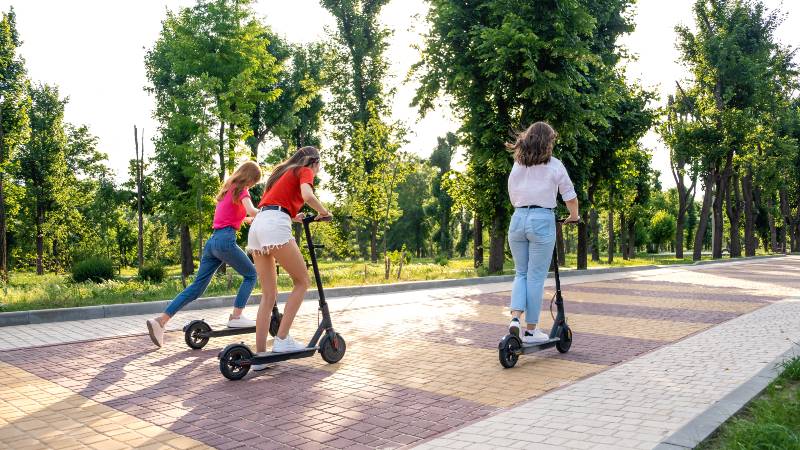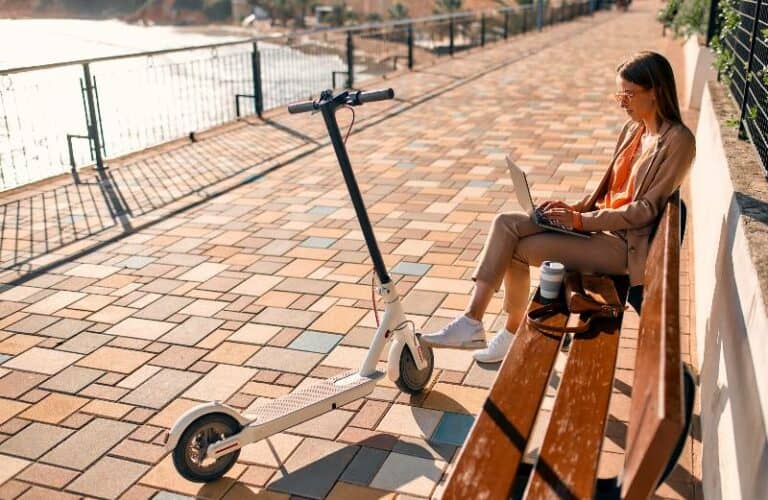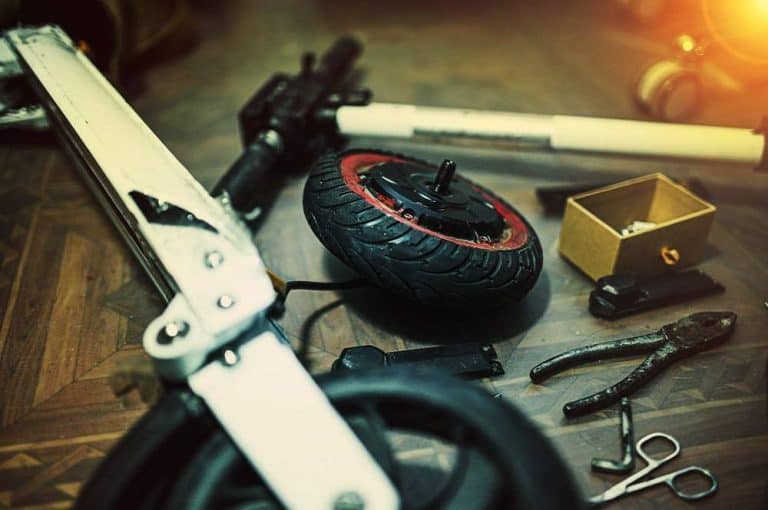Is An Electric Scooter Safe
Electric scooters have taken the world by storm in recent years. Cities around the globe are struggling to figure out how to deal with this new mode of transportation. While many people see electric scooters as a great alternative to cars and public transportation, there are some who ask: Is an electric scooter safe? In this blog post, we will take a look at the pros and cons of electric scooters and determine whether or not they are safe.
Yes! When used properly, electric scooters pose no safety risks. They’re built to the highest safety standards and share many features with other, similarly secure modes of transportation. The new study found that the rate of electric scooter accidents was 0.66 per million miles traveled, which was five times lower than the rate of accidents involving bicycles, which was 3.33 per million miles traveled.
Key Takeaways
- Electric scooters are fun, eco-friendly, and a great way to get around.
- You’ll have to follow the same rules of the road as other vehicles, but that’s not too difficult.
- Electric scooters are not allowed on sidewalks in most areas, so make sure you know the laws in your area before riding on public streets.

Are Electric Scooters Actually Safe?
Scooter Safety Report
Research has shown that e-scooters are not as dangerous as you might think, despite the reported accidents and calls to ban them. Additionally, e-scooter accidents are much less dangerous than bicycle accidents. A recent study found that e-scooters are safer to ride than bicycles.
Instead of being the fault of the inorganic e-scooters, careless riding practices on the part of the riders themselves have been found to be the most common cause of accidents. E-scooters, like any other vehicle, have the potential to fail, which can lead to accidents.
Electric Scooter Laws
The legal age to operate an electric scooter in many states is 16, though this varies from one to the next. States like Virginia have a minimum age of 14, while Utah requires people to be at least 15 years old.
States like Minnesota and Michigan have less stringent laws regarding electric scooters, allowing people as young as 12 to own and ride them.
Currently, registration is required for mopeds and bicycles but not for electric scooters. This is because electric scooters are seen as less risky to ride.
Rules Regarding Permission to Operate
However, while electric scooters are not required to be registered with the DMV in the majority of states, mopeds and motorcycles are. While there are fewer rules for e-scooters than for motor vehicles, the shared scooter industry is difficult to regulate.
However, a license is needed to operate a private electric scooter in some jurisdictions.
Mandatory Use of Helmets
Even if you’re not required to by law, you should still wear a helmet when riding an e-scooter. Even a minor collision can result in serious brain damage, so it’s best to drive as slowly as possible.
No matter how careful you are, an accident is always possible. With the increasing sophistication and speed of electric scooters, it is wise to take every precaution to ensure your safety.
All states require riders to make the responsible choice and wear helmets at all times, and most states with moped laws will use the same laws to mandate electric scooters.
High speeds are tempting and easy with E-Scooters
E-Scooters are a great way to get around town. They’re fast, convenient, and fun! But don’t let your excitement get the best of you—taking an E-Scooter at high speeds can be dangerous and can lead to serious injuries. E-Scooters are not toys. They’re motorized vehicles that can reach speeds of up to 15-30 miles per hour, so they need to be treated with respect.
E-scooters pose unique risks, but they can be managed
E-scooters are fun and convenient, but they aren’t without their own risks. In fact, they can be pretty dangerous—especially when you’re riding them on the sidewalk or in a bike lane. If you’re new to e-scooters, we’ve got some tips for staying safe on the road:
1. Watch out for pedestrians and other scooter riders. People walking or biking on sidewalks or bike paths may not see you coming and could step right into your path. And if you’re trying to use a bike lane that’s already full of bikes, it’s even more important that you pay attention so no one gets hurt!
2. Pay attention when turning corners or changing lanes—even if it seems like there’s plenty of room for everyone! You never know when someone else might be coming at high speed behind you without looking first (or even worse: someone who doesn’t know how to operate an e-scooter properly).
3. Make sure your scooter is charged before heading out! It’s not just about having enough battery power left over after your ride; if your scooter dies while you’re still on the road, you won’t be able to stop easily or safely.
4. Get a helmet! It’s not just a good idea—it’s the law in many states. And if you do have an accident, wearing a helmet can help keep you safe and prevent serious injuries like concussions and brain damage.
Safety Risks of Riding e-Scooters on the Sidewalk
The recent proliferation of shared electric scooter fleets in major U.S. cities has introduced a novel mode of transportation to the urban landscape. Municipal regulators are having trouble keeping up with their rapid proliferation, which is having an adverse effect on traffic and raising safety concerns.
According to a new report from the Insurance Institute for Highway Safety, riders and pedestrians are put in danger by e-scooters if there isn’t a plan in place for where and how they should be used.
William Wallace, manager of safety policy at Consumer Reports, says, “E-scooters can be a fun and useful way to get around, but they can also pose serious safety hazards.” Officials shouldn’t view them the same way they view bicycles. Safety should be prioritized in the development, production, and upkeep of e-scooters, and riders should adhere to best practices to reduce the risk of injury to themselves and others.
E-scooter injury data was compared to bicycle injury data collected through interviews with emergency room patients. Despite the fact that bicyclists were three times more likely to be struck by a motor vehicle, IIHS researchers found that e-scooter riders were more likely to be injured per mile and were twice as likely to be injured by potholes, pavement cracks, lampposts, and signposts.
The findings of this study shed light on the emergence of new safety concerns associated with this developing transport option. Adopters face a fusion of inexperience and a lack of suitable infrastructure, which has led to a lag in regulations despite the e-scooter market expanding at a breakneck pace as city dwellers seek inexpensive, convenient ways to avoid motor vehicle traffic. Between 2017 and 2019, the Consumer Product Safety Commission reports, e-scooters were responsible for an estimated 50,000 visits to emergency rooms and at least 27 fatalities.
Riders on e-scooters made 86 million trips in 2019, per the National Association of City Transportation Officials. According to the IIHS, even though ridership dropped during the initial months of the COVID-19 pandemic, it’s indeed likely to rise as people are seeking social way away alternatives to trains and buses travel as the disease outbreak continues, increasing the safety risk to pedestrians in areas where e-scooters must coexist with them.
The study found that the intensity of injuries sustained by e-scooter riders and bicyclists was comparable, despite the fact that the types of injuries were different. Skull fractures and unconsciousness were more common among e-scooter riders, the vast majority of whom did not wear helmets. Among those who rode e-scooters, only 2% said they wore helmets, while 66% of cyclists who needed medical attention said they wore helmets. The study suggests that fewer injuries among e-scooter users could be avoided if helmet use were encouraged and well-maintained roads were made available to them.
The Top Reasons Why E-Scooters Are Less Safe
Some e-scooters have inferior tires
Most common E-scooter models have wheels that are 9 inches or smaller, making them ideal for sharing. You won’t find any air inside of them; they’re rock solid. The intention behind the design was to cut down on maintenance expenses. The solid tires do not do a good job of damping out vibrations, however. They can’t compare to the traction of a tire filled with air. They have a hard time rolling over the bump between the sidewalk and the street, as well as the gaps between the sidewalk blocks. You might end up in an accident if you lose control like that.
Lower-End Airless Electric Scooter Tires Will Slide more Easier
The scooters with smaller wheels will slide easier. If you’re using a scooter on the slippery ground like ice, wet leaves, or gravel, you’re more likely to lose your balance and fall off than if it were road-worthy tires. They come at more of an expense upfront but will save a lot of heartache in the long run.
Fewer people use helmets while riding
There are a number of reasons why e-scooters are less safe than bicycles, but one of the most significant is that fewer people wear helmets while riding them. E-scooters are so much smaller than bikes that it’s easy for riders to forget to bring their helmet along, or they don’t think they need one because the scooter can carry them without any effort on their part.
Lower-end e-scooters have inferior braking technology
This can cause the vehicle to shake and bounce around even when you’re driving slowly and smoothly, which can be incredibly dangerous—especially in a crowded urban environment where there are lots of obstacles (like people) around! Even if your vehicle has great brakes, if it doesn’t have good suspension, then it’s more likely that your ride will be bumpy, which could cause you to lose control of your scooter at any given moment.
Smaller rear lights and a poor location
When it comes to safety, one of the biggest factors is visibility. Drivers need to see you, and you need to be able to see them. A common issue with e-scooters is that their rear lights are smaller than those on other vehicles. Because of this, they’re more difficult for drivers to notice at night or in bad weather—which means the scooter rider may not be seen by other drivers until it’s too late.
Another problem with e-scooters is that they are often placed in areas where they won’t be seen or used as intended. For instance, they may be left out on sidewalks where pedestrians could trip over them or get hit by passing cars. They can also block entrances or exits in parking lots and garages when they’re left overnight.
E-scooter safety can be improved by taking a proactive approach
E-scooter safety can be improved by taking a proactive approach.
The most important thing you can do to make sure your e-scooter is safe is to make sure it’s in good working condition. This means checking the brakes, tires, and electrical components regularly and making sure they’re not damaged or worn down. It’s also important to know how to ride safely—for example, by keeping your hands on the handlebars at all times.
You should also wear a helmet every time you ride. This will help protect you from head injuries if you fall off your scooter or get hit by another vehicle.
Tips for Improving E-Scooter Safety
1. Buy a safe scooter
The first step to improving e-scooter safety is to buy a safe scooter. You can tell if the scooter is safe by looking at its construction and materials. Make sure that the components are sturdy and durable, and look for any signs of wear or damage.
When it comes to choosing an e-scooter, you need to consider what type of terrain you will be riding on most frequently: paved roads, unpaved roads, or concrete sidewalks. If you plan to ride primarily on pavement or concrete, then your best bet is going to be a scooter with large wheels that provide good traction and stability on flat surfaces. If you plan to use your scooter mostly off-road (on dirt trails), then it’s best to go with smaller wheels so that they’ll have less trouble getting through rough terrain.
2. Follow regular road safety
When you’re on an e-scooter, you have to follow the same rules as you would if you were driving a car. This means obeying all traffic signals and signs, stopping for pedestrians, and not riding on sidewalks. It’s also important to be aware of your surroundings and watch out for other vehicles.
3. Take care in the rain
When it rains, e-scooters can become much more slippery and hard to control, so we recommend taking extra precautions when riding them in wet conditions.
If you do get caught in a downpour while on your scooter, take extra care to turn off the power and wait until the battery is completely dry before attempting to ride again.
4. Keep on top of maintenance
It’s important to keep your e-scooter in good working order. The more you use it, the more parts wear out and need to be replaced. Look out for any loose or fraying electrical wires, cracked components, or other signs that something might be broken. If you notice problems like this, get them fixed as soon as possible.
5. Know the law
In a lot of places, it’s illegal to ride an e-scooter on public roads. If you’re caught doing so, expect to get fined. In fact, you may even get charged with reckless driving if the police think you were driving recklessly while riding your e-scooter.
6. Wear a helmet
As with any other form of transportation, it’s a good idea to wear a helmet when riding an e-scooter. Helmets can prevent serious brain injuries if you’re involved in an accident. They may also help prevent neck injuries.
7. Scoot solo
The law in many places prohibits more than one person from riding an e-scooter at a time. So if you’re traveling with friends, make sure they each have their own scooter.
8. Plan ahead
Riding an e-scooter can be a lot of fun, but it’s not without risks. In order to avoid getting hurt or violating any laws, make sure you know what to do before taking off on your first ride.
9. Inspect the scooter before your ride
It’s important to inspect the e-scooter before taking off on your first ride. Make sure there’s no water in the battery compartment, and that all of the lights are working properly.
10. Take a test ride (if you’re new)
You should also take a test ride. This is especially important if you’re new to riding an e-scooter, or if you’re trying out a different brand than what you are used to. Take the scooter for a short spin around the block before taking off on your first real ride.
11. Don’t use your phone while driving
It’s important to keep your phone in a secure place while riding an e-scooter. You shouldn’t check your email, text messages, or social media while riding either. This is because it can distract you from driving safely, which could lead to accidents.
12. Slow down before looking back or turning
Looking back or turning while riding an e-scooter can be dangerous. You need to make sure that you slow down first so that you can safely turn your head or swivel your body around.
13. Avoid riding in bad weather conditions
You should avoid riding an e-scooter in bad weather conditions. This is because it can be dangerous to ride an e-scooter when there’s a lot of rain or snow on the ground. If you do decide to ride, make sure that you wear proper clothing and use extra caution while riding.
14. Avoid riding in pedestrian areas
You should avoid riding an e-scooter in pedestrian areas. This is because it can be dangerous to ride an e-scooter when there are a lot of people around. If you do decide to ride, make sure that you use extra caution while riding.
15. Know when and where to slow down
You should know when and where to slow down. This is because it can be dangerous to ride an e-scooter if you don’t know how to slow down quickly. If you do decide to ride, make sure that you know how to stop quickly.
Is An Electric Scooter Safe FAQs
What Safety Gear Do I Need?
Safety gear is an important part of your scooter experience. It’s what keeps you safe and (hopefully) protected in the event that something goes wrong.
So what do you need?
Helmet: This is probably the most important piece of safety gear for your escooter journey. A helmet should fit snugly and comfortably and will protect your head from injury if you should fall off or crash into something. A helmet can also help prevent neck injuries in the event that you fall forward onto your hands (as opposed to falling backward).
Goggles: Goggles are a great addition to any rider’s gear, as they protect against dust, dirt, and bugs—all things that can be kicked up when riding at high speeds! They also keep the sun out of your eyes when going through treeless areas or open fields.
Gloves: If you plan on using your escooter in winter conditions (which can include rain), it’s important to have gloves on hand so that you don’t get cold fingers while riding. Gloves are also useful for warm weather rides because they can help keep hands cool while making them easier to grip onto handlebars when riding fast or downhill.
And lastly, we recommend investing in a pair of elbow pads—even though they’re not required by law, they’ll help protect your arms when you’re riding at high speeds or taking sharp turns.
How Should I Lock an Electric Scooter?
Traditional locks, such as D-Locks and U-Locks, are the most reliable ways to keep your scooter secure. This lock holds virtually all Sold Secure Gold certifications. To secure the scooter to something solid, you can use a D-Lock, a hardened steel shackle.
You’ll need either powerful bolt cutters or power tools to get through these. All but the most determined thief will be deterred by these locks. The D-immobility, Lock’s in comparison to more flexible options like chains or cables, is a significant drawback.
Is an electric scooter safer than a bike?
Compared to bicycles, which had an accident rate of 3.33 per million miles, the rate of accidents involving electric scooters was 0.66, according to the new study.
Motorcycle riders have 5.88 times the accident rate of e-scooter riders.
Are electric scooters safe for seniors?
To answer your question, yes, e-bikes are safe for the elderly to ride. They are not only risk-free but also beneficial in many ways, from improving physical fitness to enhancing mental and cognitive function.
What causes e-scooter accidents?
In short, the main causes of e-scooter accidents are:
1. Speed – The faster you go, the harder you fall.
2. Weather – Rain and wind can make it difficult to stay upright on an e-scooter.
3. Dangerous drivers – You should always be looking out for other drivers as well as pedestrians when riding your e-scooter.
Conclusion
In the end, it really depends on how comfortable you are with taking risks. If you follow all the safety guidelines and use caution, then riding an electric scooter can be just as safe as anything else. Just make sure that you know your capabilities and limitations, and always wear a helmet!





